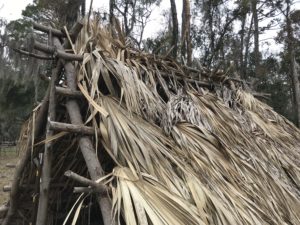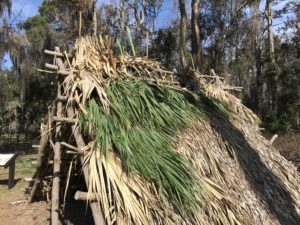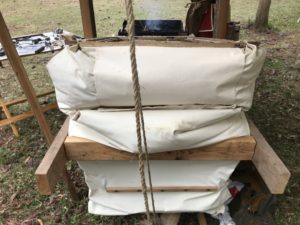This is our third season at Fort Frederica National Monument. Tom and I love it here. The weather is gorgeous January through April and there is plenty to do on the island. We go to movies, have our choice of restaurants, check out the fun and funky shops, and only drive three miles to the grocery store. Tom loves being a British soldier and we both enjoy doing living history in 1742. But so far this year, we have spent a lot of time repairing what we made before.
Two years ago – 2017 – Tom and Randy, another volunteer, built a palmetto hut. They worked really hard on it. Like most things Tom builds, the hut is plenty sturdy. When Hurricane Irma came in September that year, the palmetto hut barely lost a leaf. Although lots of trees fell around the park, nothing fell on the hut and the hut was not damaged. Then, on January 2, 2018, there was a big ice storm. Lots of limbs came down in the park but the palmetto hut was fine.
 Although Hurricane Michael dropped plenty of rain on this area last fall, the hurricane moved past the island with very little damage. Again, the palmetto hut was fine. But just a few weeks later, the park suffered a windstorm. Because most of the loose trees and branches were knocked down by hurricanes in 2016 and 2017, the park didn’t have much damage. Except for the poor palmetto hut. Suddenly there were windows were no windows should have been. Big holes showed through the gaps in the palmetto branches.
Although Hurricane Michael dropped plenty of rain on this area last fall, the hurricane moved past the island with very little damage. Again, the palmetto hut was fine. But just a few weeks later, the park suffered a windstorm. Because most of the loose trees and branches were knocked down by hurricanes in 2016 and 2017, the park didn’t have much damage. Except for the poor palmetto hut. Suddenly there were windows were no windows should have been. Big holes showed through the gaps in the palmetto branches.
Some people tried repairing the palmetto hut but they must not have spent much time with it. When we got here after the government shutdown, the thatch on the hut looked pitiful. The holes remained and seemed to get bigger every day.
 So Tom spent some time last week harvesting palmetto branches with long enough stalks to weave into the thatch. Although it was difficult to do by himself, he worked until he couldn’t reach any higher. The bright green looks incongruous against the aged thatch, but the holes are filled and we think they will hold for a while. We still need to get up higher and do the sides but both of us need to be working on that.
So Tom spent some time last week harvesting palmetto branches with long enough stalks to weave into the thatch. Although it was difficult to do by himself, he worked until he couldn’t reach any higher. The bright green looks incongruous against the aged thatch, but the holes are filled and we think they will hold for a while. We still need to get up higher and do the sides but both of us need to be working on that.
The second thing that needed repairing was the bellows we built last year. The bellows is made out of canvas because we couldn’t afford leather. The canvas works well enough and was definitely less expensive. Last year Tom was very careful with the bellows, putting it away and covering it with a tarp after every use.
When we got to the park in January, we noticed that the forge and bellows had been left sitting out in the weather. When Tom went to use the bellows last Saturday, the back of one section blew out. It looked like mold had weakened the cloth and then the air pressure caused it to rip. You can’t forge without a bellows and you can’t have a bellows with a hole in it.
 Consequently, last Saturday saw me standing at the bellows in my colonial garb, sewing a big canvas patch on the bellows. Repairing the bellows sounds easier than it was. The canvas is very thick and stiff and I was trying to sew the patch onto the already built section of the bellows. I ended up with holes in eight of my fingers from the needle (I have two thimbles), bloodstains on the canvas, and two bent needles. It took me three hours, but finally I got a patch over the hole. Tom tried it and the bellows inflated without any problem.
Consequently, last Saturday saw me standing at the bellows in my colonial garb, sewing a big canvas patch on the bellows. Repairing the bellows sounds easier than it was. The canvas is very thick and stiff and I was trying to sew the patch onto the already built section of the bellows. I ended up with holes in eight of my fingers from the needle (I have two thimbles), bloodstains on the canvas, and two bent needles. It took me three hours, but finally I got a patch over the hole. Tom tried it and the bellows inflated without any problem.
Repairing stuff we built is a little frustrating. People need to take better care of things! But it is good to know we can come up with solutions for new problems. Nothing about colonial living was easy, and no one ever said doing living history for the period would be easy either.
